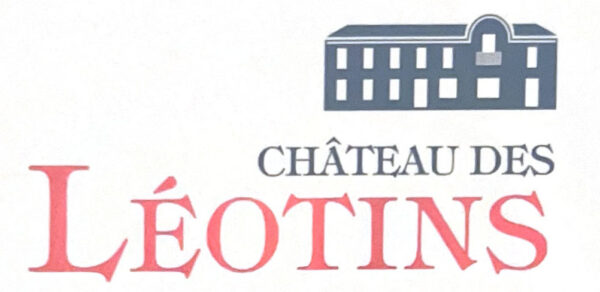
The Estate
Since 1840, the Lumeau family’s passion and tradition of winemaking has been firmly rooted in the history of Sauveterre de Guyenne. The estate has been faithfully handed down from father to son for eight generations. Today, it’s Xavier who lovingly carries on the family passion. The Lumeau winery is a vivid reflection of this family heritage, housing the family’s estates and tenderly watched over by grandparents who make sure everything runs smoothly. The eight employees who work with the family are perfectly integrated into life at the estate. Some have been sharing the values and friendly atmosphere of the Lumeau family for over fifteen years. This close link between past and present, business and family, illustrates the durability and warmth of the family’s commitment to winegrowing.
Viticulture
The vineyard grew from 45 hectares in the 1980s to over 140 hectares today. The estate has been certified HVE 3 (high environmental value level 3) since 2019, illustrating its commitment to eco-responsibility by preserving 25 hectares of woodland which protect the biodiversity of the wine estate. Phytosanitary products are used sparingly, and a wastewater treatment plant has been installed on the vineyard.
Vinification
The Lumeau family’s passion for viticulture is fully revealed in the winery, a space dedicated to the art of winemaking. Here, technical innovation is combined with traditional know-how, in an environment where stainless steel dominates.
The collaboration between the winemaker and the oenologist, Mathieu Rey, is crucial. Together, they orchestrate every step, from grape selection to bottling, ensuring that each cuvée reflects Lumeau’s commitment to excellence.
It all starts with quality grapes, followed by the reception of the harvest. For red wines, cuvaison brings out the flavors by macerating grapes, skins, seeds and juice. After fermentation, the wine is aged in oak barrels or stainless-steel vats, before being carefully bottled on the estate.
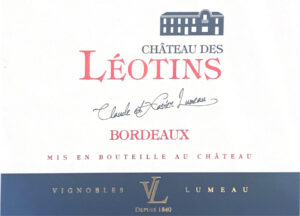
Château Des Leotins Bordeaux Rouge
Grape Varieties: Merlot, Malbec, Cabernet Sauvignon. Blended from the best vats in the vineyard.
Vinification: Cold maceration for 3 to 5 days. Fermentation at 25° followed by a long cuvaison.
Aging: This wine is aged in stainless steel vats.
Tasting Notes: Draped in an elegant crimson color with purplish highlights, this cuvée delivers delicate aromas of jammy strawberries. On the palate, the freshness of its body is supported by supple tannins that leave a delicious finish of blackberry coulis. Enjoy without delay.
Food Pairing: It delicately underscores the flavors of ham and warm goat’s cheese, game, and red meats.
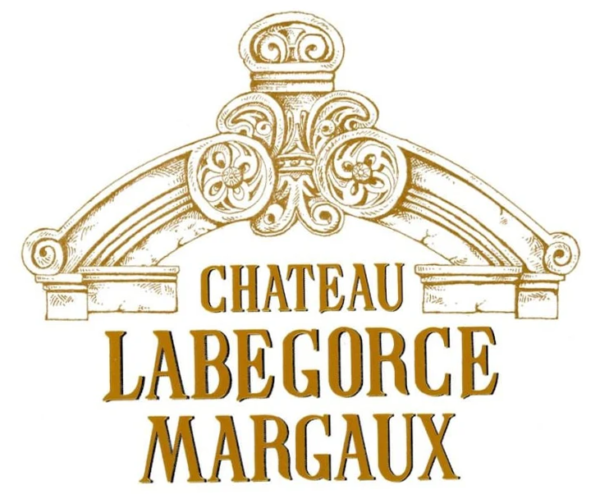
The Estate
This elegant, neoclassical château is located in the heart of Margaux, on the famous Route des Châteaux. Approximately 70 hectares of the 250-hectare estate are devoted to viticulture. Unusual for Bordeaux, they own a small 4-hectare plot of vines over 100 years old. The remainder of the vines were planted from the 1950s onwards.
Bordering on Châteaux Margaux and Lascombes, this property is mentioned in the 1868 edition of Cocks and Feret (“Bordeaux and its Wines”), which tells us of the existence since 1332 of “a vineyard belonging to the noble La Bégorce family”. The château is described as “… one of the most beautiful and best situated in the town of Margaux”.
The Perrodo family acquired Labégorce in 1989 and renovated not only the château building, but also the vineyard. It was Hubert Perrodo’s dream to join the previously divided estates of Labégorce and Labégorce-Zédé, and this was finally achieved in 2009. After Hubert’s untimely death due to a skiing accident, his daughter Nathalie took over ownership of the chateau, and runs it to this day.
The wines of Labégorce are charming with beautiful structure, bright fruit, and great finesse, and are some of Bordeaux’s most in-demand wines on the marketplace.
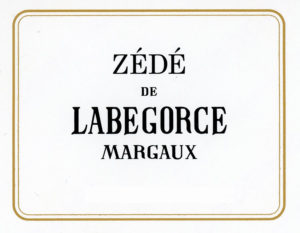
Zédé de Labégorce
Overview: Zédé de Labégorce is the second wine of Château Labégorce.
Owner: Nathalie Perrodo
General Manager: Marjolaine Maurice de Coninck
Surface Area: 70 ha
Grape Varieties Planted: 50% Cabernet Sauvignon, 45% Merlot, 3% Cabernet Franc, 2% Petit Verdot
Annual Production: 120,000-140,000 bottles
Aging: 12-14 months in barriques (40-50% new wood)
Soil: 70% sandy gravel, 30% sand and silt
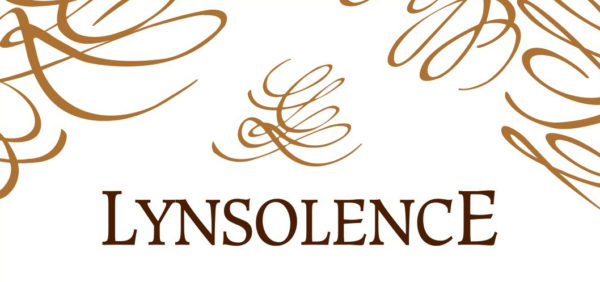
The Estate
This estate has been family owned since it was first created at the end of the 19th century. Pierre-Henri Descrambe, grandfather of the current owner Denis Barraud, enlarged the estate and passed the property and his love of the vine on to his grandson. Denis has been in charge since 1971.
Denis’ philosophy is that you can only make good wine if you have meticulously looked after the vines so that they give you good grapes. He takes great pains over the viticultural methods to obtain perfectly ripe grapes. He then vinifies in such a way as to let these ripe healthy grapes express themselves and in so doing, perfectly reflect the wonderful terroir.
Since 1998 the cuvée Lynsolence, named by Denis’ daughter Sandra who also designed the label, is the perfect example of the depth and finesse that he seeks in all the wines of Vignobles Denis Barraud.

Château Lynsolence Saint-Émilion
Appellation: Saint-Emilion Grand Cru
Production Area: 2.5 Ha (6 acres) in the commune of St. Sulpice de Faleyrens at “Le Bert”. These parcels have an excellent microclimate and are next door to such famous estates as Mr. Perse’s Chateau Monbousquet and Mr. Thunevin’s Chateau Valandraud.
Soil: Very gravelly sand, deep gravels, cool ferriferous sub-soil.
Average Age of the Vines: 45-50 years old. These are the oldest vines owned by Denis Barraud.
Grape Varieties: 100% Merlot
Planting Density: 5,600 plants/ha, low yielding grafting stock.
Average Yield: 19-25 hl/ha
Harvest: Manual harvesting with rigorous selection on tables.
Viticulture: All the rows of vines are grassed. Throughout the growing season, Barraud controls this grass with a mower which cuts right under the vines. Deleafing and green harvesting in June and August, manual removal of spurs, soil improvement using organic materials exclusively.
Vinification: The bunches are destalked and then gently crushed in a destalking/crushing machine. Using a gentle Archimedes’ Screw, the harvest is transferred to two wooden vats of 50 Hl each. This type of pump had the advantage of neither mashing nor harming the grapes. The wooden vats are thermostatically temperature controlled. They are only used for maceration and fermentation. Before fermentation takes place, the harvest undergoes cold (10°C 50°F) maceration for 9 or 10 days. Alcoholic fermentation lasts 8 to 10 days. The post fermentation maceration takes place at 30°C, (77°F) for 20 to 25 days, with the cap being pushed down once a day (“pigeage”). Regular tasting informs Barraud when maceration should stop, and he then transfers the wine to new barrels, made from French oak from the Tronçais Forest. The malolactic fermentation takes place in these new barrels.
Aging: Once malolactic fermentation is over, Barraud racks off the wine, washes the barrels and puts the wine back for about 18 months. The wine is then racked every 3 to 4 months.
Tasting Notes: Nearly black in color, very concentrated and fruit forward. The nose is creamy, with notes of cashew and Morello cherry, bursting with fruit. On the palate, it is supple, silky, full-bodied, and well built. It finishes very long.

The Estate
Since 1881 and until Sylvie Cazes and her children took over in May 2014, the Ondet family took great care of Château Chauvin and gave it all their know-how. Sylvie Cazes, a passionate winegrower who fell for the charms of this beautiful property, now wants to give Chauvin every opportunity for success in this new page in its history. As a result, after buying the property, she undertook an ambitious program of restructuring of the viticultural and winemaking techniques. With precision and rigor, with respect for the terroir of Saint-Emilion and the conditions specific to each vintage, Sylvie Cazes and her team have created elegant, balanced, feminine and classy wines with the potential for aging.
Château Chauvin is located to the northwest of Saint-Émilion, halfway between Cheval Blanc and the Butte de Rol, close to the Pomerol appellation.
The soil at Chauvin is sandy clay, benefiting from the presence of a pseudogley and an iron-rich subsoil similar to that found in parts of Pomerol. Thanks to its lower water retention capacity, the soil rapidly succumbs to water shortages, thus allowing the grapes to ripen more quickly. The efficient drainage of the entire vineyard also allows run-off of water during the wettest periods.
The vineyard is in a single block surrounding the property, thereby facilitating the meticulous vineyard work carried out by the team at the Château. It is mostly planted with Merlot (75%), which expresses itself admirably in this vineyard. The areas showing the most clay are planted with Cabernet Franc (20%) and Cabernet Sauvignon (5%), varieties that fit in perfectly with this type of soil. The vineyard is managed with the greatest respect for the terroir, so as to bring out its purest expression. Sylvie Cazes and her team strive to produce a wine that is a faithful reflection of the land.

Château Chauvin Saint-Émilion Grand Cru Classé
Owner: Sylvie Cazes
Consultant Oenologist: Michel Rolland
Technical Manager: Jérémie Gravier
Location: To the north-west of Saint-Emilion, between Cheval Blanc and the Butte de Rol
Grape Varieties: Merlot 75%, Cabernet Franc 20%, Cabernet Sauvignon 5%
Average Age of the Vines: 30 years
Plant Density: 7,000 vines / hectare
Production Area: 15 hectares
Soil: Sandy-clay soil with the presence of ferruginous sandstone, clay sub-soil
Annual Production: 50,000 bottles of 1st wine, 20,000 bottles of 2nd wine
Viticulture: HVE certification (High Environmental Value) level 3. Mechanical working of the soil between the vines and central grass cover. Manual viticulture: trunk cleaning, leaf removal and thinning out. Use of sexual confusion.
Harvest: By hand, in open crates of small capacity. Hand sorting in the vineyard and double hand sorting in the cellar.
Vinification: Cold skin contact for 2 to 5 days at around 8°C before fermentation. Alcoholic fermentation in temperature-controlled stainless-steel tanks. Malolactic fermentation in barrel. Skin contact for 20 to 30 days – slow and gentle extraction
Aging: French oak barrels for 15-18 months, 60% new barrels.
Label: A Château Chauvin label that had been used in 1929 really appealed to Sylvie, who decided to use it as the model for the creation of a new label. After that, the graphic research went back to the meaning of the word “chauvin”. To be “chauvin” in French means to be proud of your land, to love your land. To illustrate these values, a symbol was added to the original label dating from 1929: Cupid, god of Love, proudly displays a banner depicting the emblematic lion of Saint Emilion, overlooking his land with a watchful eye. As from the 2014 vintage, this symbol appears on the label of Château Chauvin to represent the attachment to the terroir of Saint-Emilion.
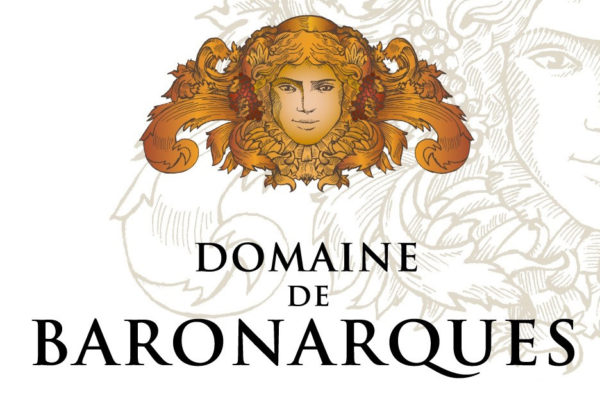
The Estate
Domaine de Baronarques is a very old estate, dating back at least to the 17th Century, when it was called Domaine de Lambert. At the time, the estate belonged to the Abbey of Saint-Polycarpe, a village near Limoux in the Aude department of Southern France.After changing hands several times, the estate was sold to Michel Tisseyre in 1875. The Tisseyre family extended the vineyard – it covered 48 hectares (120 acres) in 1910 – and between 1890 and 1900 built themselves an attractive residence with a terrace and a garden.
In 1998 Mr. Chéreau, a Marseilles lawyer and heir of the estate, sold it to Baroness Philippine de Rothschild and her two sons. The three entrusted the management of the Domaine to the family company, Baron Philippe de Rothschild S.A. The estate was very run down, calling for extensive renovation of the vineyard and the winemaking facilities, a process that took five years.
In 2003, Domaine de Baronarques benefited from a fortunate conjunction of circumstances: the wine proved to be of very high quality and the Domaine was awarded the AOC Limoux rouge appellation, newly created by the Institut National des Appellations d’Origine (INAO). Domaine de Baronarques could take its rightful place alongside the family’s other estates, including the illustrious Château Mouton Rothschild.
Camille Sereys de Rothschild joined the original buyers, Philippe Sereys de Rothschild and Julien de Beaumarchais de Rothschild, her brothers, in 2014.
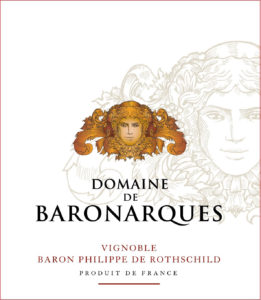
Domaine de Baronarques Limoux Rouge
Location: Domaine de Baronarques is located in Languedoc, in the commune of Saint-Polycarpe, near Limoux. The Domaine is a single 110-hectare (272-acre) estate, 43 hectares (106 acres) of which are planted with vines.
Climate: Located 400 km from the Atlantic Ocean and 100 km from the Mediterranean, the vineyard is subject to the climatic influence of both water masses, ensuring optimum sunshine and balanced rainfall. Also close to the Pyrenees, the parcels are at an altitude of 250 to 350 meters, tempering the summer heat.
Soil: The soil is mainly clay and limestone, except for a few parcels where there is more gravel and sand.
Grape Varieties: The vineyard is planted with 70% Bordeaux varieties (Merlot, Cabernet Sauvignon, Cabernet Franc) and 30% Mediterranean varieties (Syrah, Grenache and Malbec) for the red wines and 100% Chardonnay for the white wine.
Vine Density: Seeking the best possible quality, Domaine de Baronarques has opted for high-density planting: 7,500 plants per hectare on 10 hectares (25 acres) of the estate and 4,600 plants per hectare on the other parcels (most vineyards in the region are planted with a density of around 3,000 plants per hectare).
Viticulture: The vineyard practices at the Rothschild family’s other estates (disbudding, leaf removal, cluster thinning) are well-suited to the Domaine’s different types of soil, microclimates and grape varieties.
Harvest: The grapes are harvested by hand in 12-kilo open baskets, as in the family’s Bordeaux vineyards.
Vinification: The grapes are sorted above the vat room and fed into the vats by gravity, a process which helps to keep the fruit whole. They are then gently destemmed and lightly crushed, and fermented in stainless steel vats. Alcoholic fermentation lasts about 8 days at a maximum temperature of 30°C. It is followed by a maceration period lasting 2-4 weeks depending on the wines and the grape varieties.
Aging: After malolactic fermentation, the premium red wine is matured for 12 months in oak barrels, either new (25-50% depending on the vintage) or one to three years old.
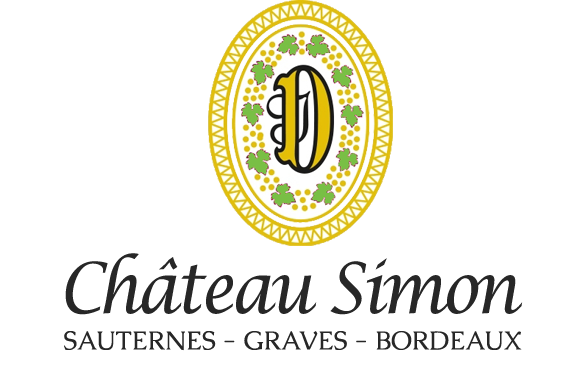
The Estate
Ideally positioned a few hundred meters from the village of Barsac in the Simon neighborhood, Château Simon has thrived here for 2 centuries.
Established in 1814, Château Simon began as a traditional French farm producing wine, fruits & vegetables. Over time, the estate has successfully prevailed as a strong wine producing specialist.
Today, the vineyard spans an impressive 33 hectares located on 3 major appellations: Sauternes, Graves, & Bordeaux. The vineyard produces wine varieties such as Sémillon, Sauvignon, Merlot, & Cabernet Sauvignon. Anne Laure Dufour-Bonnard & Pauline Dufour-Descamps remain loyal to their roots and honor their heritage by utilizing the invaluable knowledge and traditions of their ancestors alongside modern & innovative techniques.
Château Simon offers a large range of wines: Barsac-Sauternes, Graves Red, White & Sweet, Bordeaux Red, White & Rosé. For almost 3 decades, they have been an active member of the Vignerons Indépendant association.
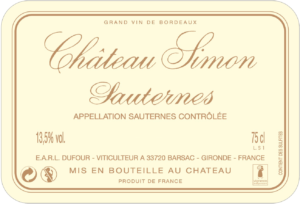
Château Simon Sauternes
Terroir: The vines are located in the Haut Plateau in the commune of Barsac on a unique clay and limestone soil resting on rocks with asterias (fossils).
Grape Varieties: 80% Sémillon, 18% Sauvignon Blanc, 2% Muscadelle
Viticulture: Sustainable viticulture techniques are widely used at the vineyard, where they implement modern bio-control solutions. Château Simon is proudly certified to High Environmental Value Level II.
Harvest: The grapes are handpicked with meticulous care, about 4-5 pickings. Only the overripe grapes are selected (botrytis cinereas).
Vinification: The botrytised grapes are delicately pressed for one night. After a cold soak, the must is fermented in thermo-regulated stainless steel tanks. The best pressings are selected and aged in oak barrels for 18 months.
Annual Production: 26,000 bottles
Winemaker Tasting Notes: “With a splendid gold robe, this wine has an intense nose of supple exotic fruits and citrus fruits. The attack is round and fruity with an ample evolution, rich and fresh. The finish is full of spicy notes and a delicate touch of freshness with a slight minty character.”
Food Pairings: This wine can be served as a brilliant aperitif with blue cheese. It is a perfect companion to white meats, spicy dishes, Asian cuisines and the traditional foie gras.
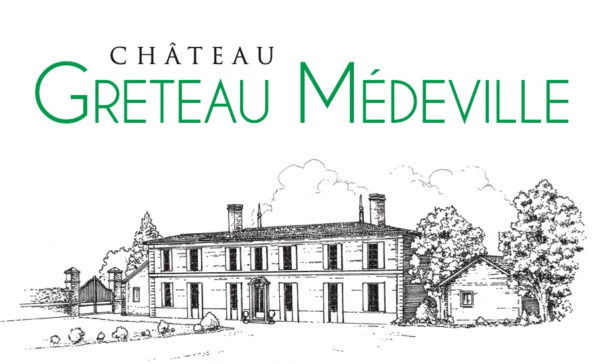
The Estate
Dating back to the 17th century, Gréteau’s noble house was originally a hunting lodge owned by the Duke of Epernon. Situated on the right side of the Garonne River, the 9-hectare estate has a limestone subsoil, clay and limestone sloping terroir, and is planted mainly with Semillon and Sauvignon grapes.
Owner: Famille Medeville & Fils
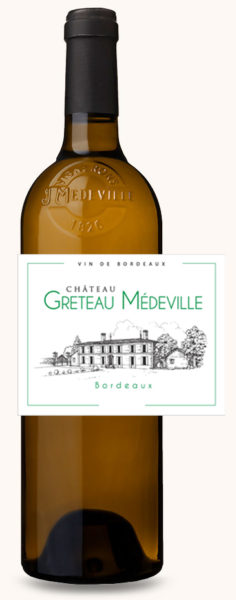
Château Gréteau Medeville Bordeaux Blanc
Production Area: 2 hectares
Soil: Clay-limestone
Average Age of the Vines: 35 years old
Viticulture: Certified Sustainable. Green field (EMS – Environmental Management Sytem – and ISO – International Standard Organization – 14001)
Harvest: Manual harvest
Vinification: After maceration and pressing, the must is settled. Controlled at low temperature during the whole fermentation, the wine is then aged on fine lees for 2 months. Bottled at the property 4-5 months after the harvest.
Annual Production: 20,000 bottles
Grape Varieties: Sauvignon Blanc, Muscadelle, Sémillon
Alcohol Content: 13.5%
Tasting Notes: Nice color, intense nose with notes of fruit. Good attack on the palate with nice acidity. Very fresh finish.
Food Pairings: Seafood, spicy foods, fresh goat cheese.
Serving Suggestion: Serve between 8-10°C
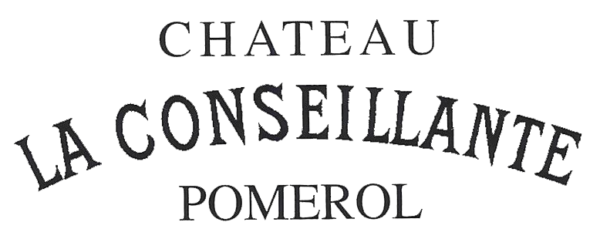
The Estate
The first recorded history of La Conseillante’s name appears in the mid-18th century. It was bequeathed by an influential woman who owned the estate almost 300 years ago, Catherine Conseillan.
The Nicolas family bought the chateau in 1871, and its size and configuration have not changed since. Exemplifying the Nicolas family’s continued commitment to this great wine, the 5th generation is currently at the helm.
Located at the heart of the famous Pomerol plateau next to its renowned neighbors, Pétrus and Cheval Blanc, La Conseillante has an outstanding terroir. Its full potential has been achieved, and the wine has gained a well-deserved reputation for power and elegance.
La Conseillante’s silky tannins, aromatic complexity, and consistency in quality year in and year out account for its loyal following around the world.

Château La Conseillante Pomerol
Owner: Nicolas family (since 1871)
Managers: Dr. Bertrand Nicolas & Jean-Valmy Nicolas
Managing Director & Winemaker: Marielle Cazaux
Consultant Oenologist: Michel Rolland
Cellarmaster: Patrick Argutti
Production Area: 11.8 hectares, 70% dedicated to the 1st wine and 30% to the 2nd wine, Duo de la Conseillante
Soil: 60% grey clay, 40% sandy gravel, over an iron-rich, clayey subsoil
Grape Varieties: 80% Merlot, 20% Cabernet Franc
Plant Density: 7,000 vines/hectare
Average Age of the Vines: 35 years old
Viticulture: Since 2016, La Conseillante has implemented a series of undertakings to reduce its environmental impact. The estate has gained ISO 14001 and HVE 3 certification within the SME programme (Environmental Management System) for Bordeaux wines.
ISO 14001 certification implies the limitation of environmental impacts within a company. HVE 3 certification (High Environmental Value) is centered around 4 separate environmental themes: biodiversity, phyto-sanitary strategy, management of fertilization and water resources. La Conseillante also cultivates different species of plants, such as clover (used in different parts of the vineyard where vines lack vigor) and oats (used to break up the soil with their roots). Radish is also planted, particularly in clay parts of the vineyard, where it enables de-compacting and aeration of the soil. Their environmental policies continue to develop and increase, and they have undertaken to include in their vine-growing practices biodynamic farming and phytotherapy, and more than 80% organic and/or biocontrol products. These elements all enhance biodiversity within the La Conseillante vineyard.
Harvest: By hand in low-capacity, open trays. Green harvesting.
Vinification: Pre-fermentation cold-maceration for 2-5 days, in tank for 3-4 weeks. Stainless steel vats, fully temperature-controlled.
Aging: 18 months – new barrels 50-75%. Fining with egg whites; no filtration.
Annual Production: 45,000 bottles
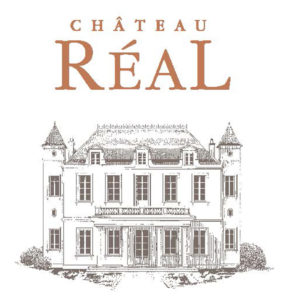
The Estate
Château Réal is operated by the owner of Château Serilhan, Didier Marcelis. It is the last chateau belonging to the Tronquoy family, former owner of Châteaux Montrose and Tronquoy Lalande. The wine is vinified by Hubert De Boüard, current owner of Château Angélus. Following the renovation of the cellars, this property became eligible for the Cru Bourgeois for the 2010 vintage.

Château Réal Haut-Médoc
Appellation: Haut-Médoc
Production Area: 6 hectares, all in Haut-Médoc, around the cities of St Seurin de Cadourne and Cissac-Medoc
Soil: Gunzian gravel, clay, and limestone
Average Age of the Vines: 35 years old
Grape Varieties: 57% Cabernet Sauvignon, 35% Merlot, 8% Cabernet Franc
Viticulture: Cover crop, ploughing, crop-thinning, and leaf-thinning
Harvest: Manual
Vinification: Sorting table. Steel tanks. Vatting for 25 to 30 days. Cold maceration for 4 days. Pneumatic pressing.
Aging: 18 months in barrel
Annual Production: 20,000 bottles
Alcohol: 14%
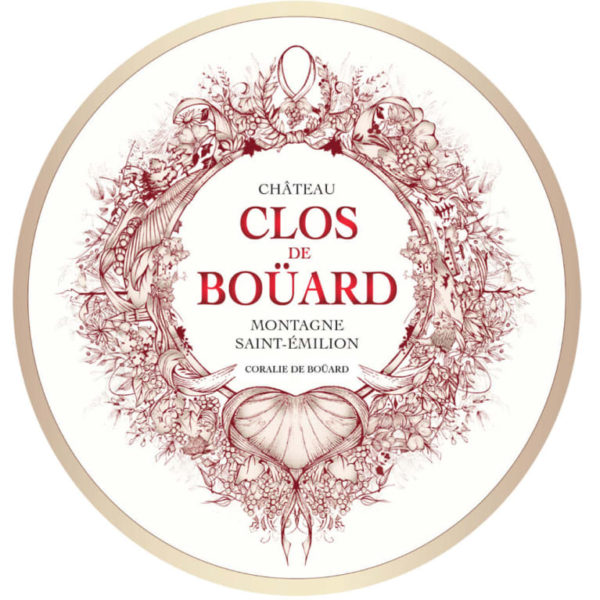
The Estate
Château Clos de Boüard has a well-exposed terroir, 30 hectares, in the town of Parsac, historically renowned for the richness and quality of its exceptional clay-limestone terroirs. Located near Grands Crus Classés and similar of Saint-Emilion: the castles Fombrauge, Laroque, Rocheyron, Croix de Labrie, Château Louis, Fleur Cardinale, Valandraud and Troplong Mondot.
The property benefits from a privileged biodiversity and ecosystem with a strong presence of old vines. Investments to restructure the vineyard are underway in order to produce high quality wines with silky, velvety tannins, respectful of the fruit, full of elegance, delicacy and freshness, wines that are the signature of know-how and family expertise.

Dame De Boüard
Grape variety: 60% Merlot, 30% Cabarnet Franc, 10% Cabernet Sauvignon
Vineyard area: 30 hectares
Appellation: Montagne Saint-Émilion
Soil type: Clay-limestone
Average age of the vines: 40 years
Production: 45 hecto/ha
Winemaker: Coralie de Boüard de Laforest
Aging: 10-14 months; 30% new barrels.
Harvest period: September 25th-October 9th.
Alcohol: 15%


